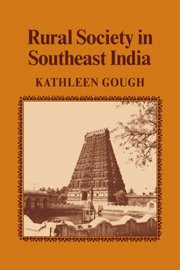Book contents
- Frontmatter
- Contents
- Preface
- Part I Thanjāvūr
- Part II Kumbapeṭṭai
- 8 The Face of the Village
- 9 Kumbapeṭṭai before 1855
- 10 Kumbapeṭṭai from 1855 to 1952
- 11 The Annual Round
- 12 Economics and Class Structure: The Petty Bourgeoisie
- 13 Independent Commodity Producers and Traders
- 14 The Semiproletariat
- 15 Village Politics: Religion, Caste, and Class
- 16 Village Politics: The Street Assembly
- 17 Class Struggle and Village Power Structure
- Part III Kirippūr
- Notes
- Glossary
- Bibliography
- Index
- CAMBRIDGE STUDIES IN SOCIAL ANTHROPOLOGY
10 - Kumbapeṭṭai from 1855 to 1952
from Part II - Kumbapeṭṭai
Published online by Cambridge University Press: 29 October 2009
- Frontmatter
- Contents
- Preface
- Part I Thanjāvūr
- Part II Kumbapeṭṭai
- 8 The Face of the Village
- 9 Kumbapeṭṭai before 1855
- 10 Kumbapeṭṭai from 1855 to 1952
- 11 The Annual Round
- 12 Economics and Class Structure: The Petty Bourgeoisie
- 13 Independent Commodity Producers and Traders
- 14 The Semiproletariat
- 15 Village Politics: Religion, Caste, and Class
- 16 Village Politics: The Street Assembly
- 17 Class Struggle and Village Power Structure
- Part III Kirippūr
- Notes
- Glossary
- Bibliography
- Index
- CAMBRIDGE STUDIES IN SOCIAL ANTHROPOLOGY
Summary
The century after about 1855 was one of momentous change in Kumbapeṭṭai as in all of Thanjāvūr. Merchant capitalism made much deeper inroads, and the colonial economy of crop and labor exports and manufactured imports was firmly established.
Labor Migration Abroad
As we saw in Chapter 6, Thanjāvūr became “hooked” to the new plantations of Ceylon, Malaya, the Western Ghāts, and other regions, as early as 1840, supplying both indentured laborers and the paddy to feed them. Perhaps associated with the need for plantation labor and for greater mobility of labor in India in general, slavery was gradually abolished in law between 1843 and 1861. Act V of 1843 forbade masters to beat their slaves, allowed slaves to own property, and, although it did not forbid slave owning, made it impossible to uphold the claims of slave owners in law. In 1861, slave owning was forbidden under the penal code.
Perhaps about forty of Kumbapeṭṭai's Paḷḷars migrated to the plantations of Ceylon, Malaya, Burma, and Mauritius in the second half of the nineteenth and the early twentieth centuries, as did several hundred Paḷḷar, Parayar, Kaḷḷar, and Paḍaiyācchi laborers from adjacent villages. Until 1918 they went as indentured laborers; thereafter, as free wage laborers who, however, had to pay off the price of their passage through work on arrival. A small proportion of these laborers returned after ten to twenty years, some of them having fled before the Japanese advance in World War II.
- Type
- Chapter
- Information
- Rural Society in Southeast India , pp. 193 - 212Publisher: Cambridge University PressPrint publication year: 1982



